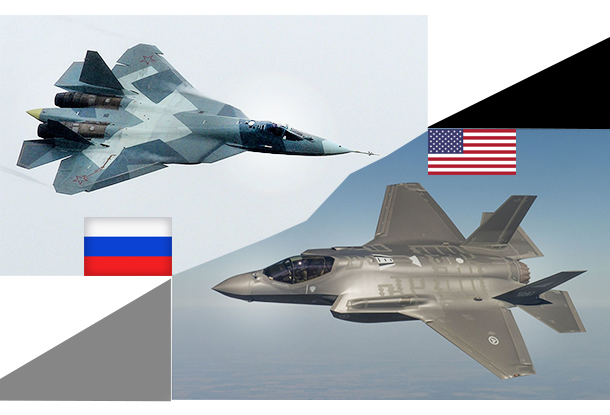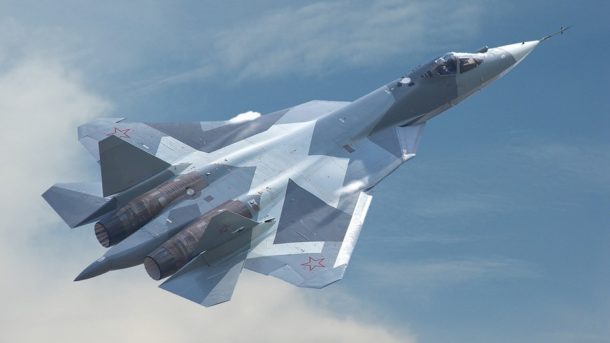
Su-57 retains a considerable advantage over the F-35 in the air, according to Military Watch. But there is a big question: is the comparison legitimate in the absence of real data?
Military Watch says the two fighters are significantly different. Lockheed Martin F-35 is a light aircraft with lower than average maneuverability. It was designed as a lighter and less costly complement to the elite F-22 Raptor air superiority fighter, a platform no longer in production.
The Su-57 by contrast was designed as a heavy air superiority platform and is more capable in an air-to-air combat role, adds Military Watch. The analysis gives advantage to the Sukhoi Su-57 in its speed, altitude, sensors, missile carriage, engagement range, and maneuverability.
It also reminds its readers that the US Senate adopted the 2019 draft Pentagon budget that would terminate Turkey’s participation in the Joint Strike Fighter (JSF) program. The act would also ban the transfer of rights to F-35. Among the reasons for the move is the threat that Turkey might share the data on F-35 Lightning II following its purchase of the Russian S-400 surface to air missile system. Turkey responded by promising to buy Russian made Sukhoi Su-57 instead of the US fighters.

Sukhoi PAK FA T-50 (Su-57) fifth-generation fighter aircraft © sukhoi. org / Global Look Press
According to Military Watch, in this case the Turkish air fleet would be more dangerous than it would have been if Ankara purchased the US stealth fighter. Fifth generation fighter benchmarking is a routine exercise for Western media. Domestic authors have tried their hand at it, too, but it is not that widespread in Russia.
How can you prove your point?
To start with, we do not have the data for F-35, leave along the Russian Sukhoi Su-57, although the level of transparency for foreign military hardware has traditionally been higher than in Russia. For example, it does not make sense to compare the speed parameters of operational and prototype aircraft. It is irrelevant just like the altitude.
Today, fighters do not chase each other like they used to in the skies of WWI and WWII. Maneuverability is a much more complex parameter for benchmarking. Under certain circumstances, maneuverability does play a key role but it is no longer as paramount as it used to be. To reiterate, maneuverability is not critically important for a fifth generation fighter.
READ MORE: Turkey will ‘definitely take F-35s’ despite US Congress saying ‘No’
Also, it is extremely difficult to compare the aircraft in terms of payload capability but it is a less important factor than in the past. It is clear that a 25-tonne aircraft could carry between five and eight tonnes. But it is not a must-have: the French Rafale can also carry eight tonnes. Eventually, it all comes down to the range that you can carry the payload.
Which brings us to the main point: the right combination of payload capacity and range is key for any contemporary aircraft. Basically, it means how far you can go and be still capable of waging an effective air-to-air combat. But this is exactly what’s missing in open sources: there is no available data on the combination of carriage and range for fifth generation aircraft.
Separately, the info on carriage and range would be interesting but not as important as data on the combination of the two parameters. Onboard radar specifications are a major differentiating factor. Again, it’s not its maximum range that is vital but the range of detection of specific targets with concrete radar cross section parameters.
Most military pundits are not aware of the parameters, and are unlikely to know them. And those who have the info will never share the real data about the radars on fifth generation fighters. There is another metric to judge the efficiency of a radar – jamming resistance. But you would never find any data on it.
It is clear why: it is considered one of the main radar secrets on fifth generation aircraft. Theoretically, a radar with an Active Phased Array Antenna is supposed have a higher level of ECM resistance. But we do not have the hard data about it or the materials or combination of materials have been used.
Even specialists who operate fifth generation aircraft may not know it. They might have some general ideas about the frequency range or its software but may not be briefed on what is really happening inside those devices. As for radar signature for fifth generation fighters, another critical parameter for planes of this kind, there is hardly anyone who can give you any info. There are two or maybe three labs in the world where you can measure radar signature. It is done using highly sophisticated equipment and complicated math models.
Another important factor is how well its sensors are integrated: how coordinated is the info coming from different sources including its onboard radar, electronic surveillance, airborne early warning radars, satellites, ground and airborne command posts. It is obvious that we will not be getting this data anytime soon. For example, right now the US is modifying the system that ensures 360-degree visibility for the F-35 pilot. It seems it didn’t work out, but this is based on circumstantial evidence only. There is no reliable information on the subject.
And finally, a few words on the munitions for the fifth generation fighter jets. Here, too, we have no factual information at our disposal. No one really knows what the new promising long-range air-to-air missiles could be capable of. You can make certain conclusions based on the infrared-guided missiles, but it’s much more complicated when it comes to radar guidance systems.
To sum up, most specifications of the fifth generation fighter aircraft are classified and at this stage constitute a state and military secret. Comparing them in the media is inappropriate, to say the least. At this point, all the data and comparisons published in the media can be perceived as nothing more than fake news. Getting any independent opinion on the subject would require concerted effort from the intelligence community of an entire country. Acquiring some data that way is entirely possible, but leaking it to open sources is completely unimaginable.
This article was originally published by Gazeta.ru.
Author Mikhail Khodarenok is a retired colonel. He graduated from the Minsk Higher Engineering School of Anti-Aircraft Missile Defense (1976) and the Command Academy of the Air Defense Forces (1986).
Commanding officer of the S-75 AA missile battalion (1980-1983).
Deputy commanding officer of a SAM regiment (1986-1988).
Senior officer at the High Command of the Air Defense Forces (1988–1992).
Officer at the main operational directorate of the General Staff of the Armed Forces(1992–2000).
Graduated from the Military Academy of the General Staff of the Armed Forces of the Russian Federation (1998).
Worked as an analyst at Nezavisimaya Gazeta (2000-2003) and editor-in-chief of Voyenno-Promyshlennyi Kuriyer (2010-2015).
READ MORE PENTAGON NEWS AT: 21st Century Wire Pentagon Files
SUPPORT 21WIRE – SUBSCRIBE & BECOME A MEMBER @21WIRE.TV















